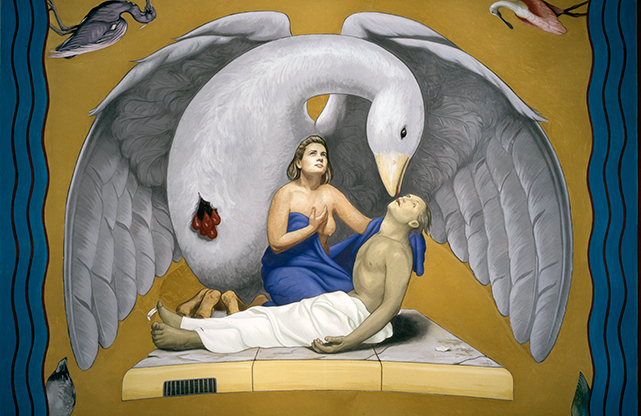The Seven Virtues
Although the concept of seven virtues is associated with Christianity, they actually predate it by several centuries. Most credit the philosopher Plato with listing a few of them. It should be noted that the idea of defining virtuous ways of being is not limited to Christianity — in Bushido, the code followed by the Japanese Samurai a set of seven virtues is described too, though these differ from traditional Christian lists. Theologians and theorists may define the virtues differently and they have undergone some changes.
Some of the early virtues described are done so in the writing of St. Paul, who talks about the greatest of these virtues being love. The other virtues St. Paul lists are called theological and are faith and hope. The remaining four virtues usually listed are called cardinal virtues, and philosophers like St. Augustine and Thomas Aquinas developed definitive lists.
The Seven Virtues
Faith is the foundation of all of the other virtues. This is why Balma's depiction of the virtue is located at the entrance of the building. A family sits together peacefully beneath the golden sun. The sun provides energy to all living things and although we cannot gaze directly at it, we believe in its power. The family represents love and commitment. The child holds a small goldfinch, a Christian symbol for Christ because of its tendency to make nests from the seeds of the thorny thistle. The overall theme of this fresco is creation, and illustrated by the Native American teaching of the tortoise volunteering his back as a place for the people to live when there was no land.
On Oct. 20, 1994, an open house was held to celebrate the completion of the Frescoes of St. Thomas. Seven community members were invited to comment about what each panel meant to him or her, personally.
The Rev. Donald Meisel, pastor emeritus of Westminster Presbyterian Church, Minneapolis, Minnesota spoke on the "Faith" panel:
"On a personal note: A 16-by-12 representation of the face of faith was given to me a year ago by the university in recognition of my having offered the invocation at the dedication of the first half of the fresco ceiling. My wife, Eleanor, had it beautifully framed. It watches over me at my desk every day. What does that face say to me? It says that faith is the conviction, the awareness that something of God is in every human face. Faith is the belief that: Faith is the conviction, the awareness that something of God is in every human face. Faith is the belief that the love of God was faced in Jesus Christ. Faith is the certainty that everyone who does the will of God is a child of God. Jesus said as much. In a world of increasing diversity, that needs to be faced. Faith is the thankful sense that by God the face of the whole earth is made new every morning, and we along with it if we but pray that it might be so. Faith is the mother of courage, of the ability to go on loving in the face of adversity, of the capacity to forgive, to be forgiven, to begin anew, of the confidence that even though so much is amiss in our world, God's love still holds sway and will have the final word. Thanks be to God."
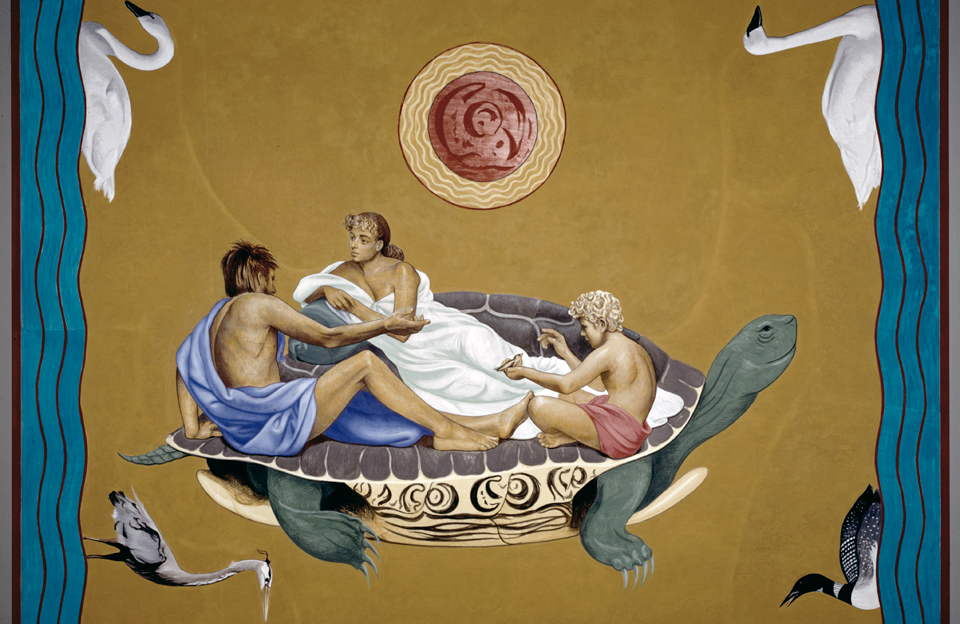
Traditionally, the virtue of justice is depicted as a blindfolded woman holding equally balanced scales. Justice is meant to be blind; it does not make judgment based on prejudice. In Balma's interpretation, the scales become the main symbolism, with the images of male and female figures balanced perfectly upon them. The figures are not blind, but they see themselves as they are in their natural state, different and unique, but equal in respect to one another on a scale which is fixed. Behind them is the dark form of a stylized eagle, wings outstretched in an upward lift. The shape of this mythical bird was inspired by the "Thunderbird" of Native American folklore. Native people believed the eagle to be the mediator between heaven and earth, as it was able to soar effortlessly. It was considered the essence of spiritual enlightenment, of principles to be upheld. This representation of the eagle was adopted by early American colonists and became the symbol of our country. The entire piece is framed by a circle, a symbol of perfection.
On Oct. 20, 1994, an open house was held to celebrate the completion of the Frescoes of St. Thomas. Seven community members were invited to comment about what each panel meant to him or her, personally.
The Hon. Rosalie Wahl, retired Minnesota Supreme Court justice, spoke on the "Justice" panel:
"Through the days and years, as our eyes are lifted to this fresco of Justice - to the outstretched wings and balanced scales - may we remember those principles to be upheld. May we remember that every person - poor or rich, black or red or brown or white, male or female - has the right to equal justice under the law. May we work together to make justice a reality in our common life."
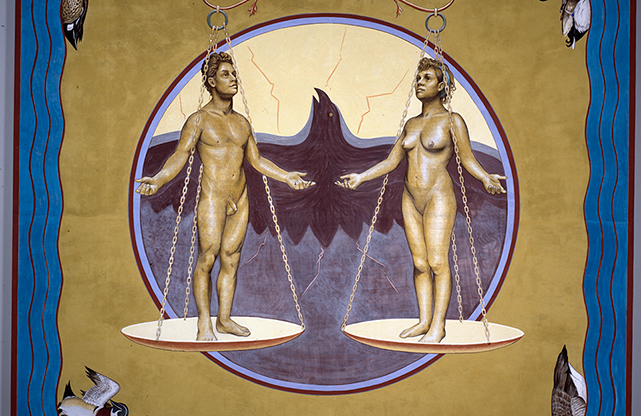
The virtue of prudence traditionally has been depicted by a figure of a teacher, denoting wisdom. Here, prudence is interpreted as the wisdom to make the right choices in life. The main symbol in "Prudence" is a large, scaly dragon. To Asian cultures, the dragon represents wisdom and supernatural powers. A woman with an academic gown stands calmly before it. She carries the book, "Sapienza," which means "knowledge" in Italian. In its mighty claw the dragon clutches a diploma. The woman is not frightened by this vision; instead, she gestures toward it, offering peace. On the other side of the great beast are the pink glimmering arches that represent passage to a more enlightened, successful life. Close examination of the two figures shows that the woman and the dragon are actually in identical poses; they mirror each other. Sometimes our greatest inhibitions are within ourselves. We must confront these weaknesses. Thus, as Socrates said, "Know thyself."
On Oct. 20, 1994, an open house was held to celebrate the completion of the Frescoes of St. Thomas. Seven community members were invited to comment about what each panel meant to him or her, personally.
Brother Michael Collins, F.S.C., president of De La Salle High School, Minneapolis, spoke on the "Prudence" panel: "In the previous reading (see description above), Prudence is referred to as the wisdom to make the right choices in life. As I reflected on that statement, I was reminded of the the choice I made nearly 40 years ago to dedicate my life to the Catholic education of young people. And even though from time to time I have weighed the wisdom of that choice against other choices I might have made, I have continued to continue. I do so, to a great extent, because young people today are also faced with many different choices – possibly more than at any time in the history of human kind. "However, for today's youth to acquire the wisdom to make the best choices in life, every adult person in our community must discover how he or she can best contribute to that endeavor. For that reason, I continue to discover anew the vitally important contribution education can make to young people's lives, and I continue to believe, moreover, that the subsequent quality of all of our lives depends – in great measure – on the quality of that education we provide."
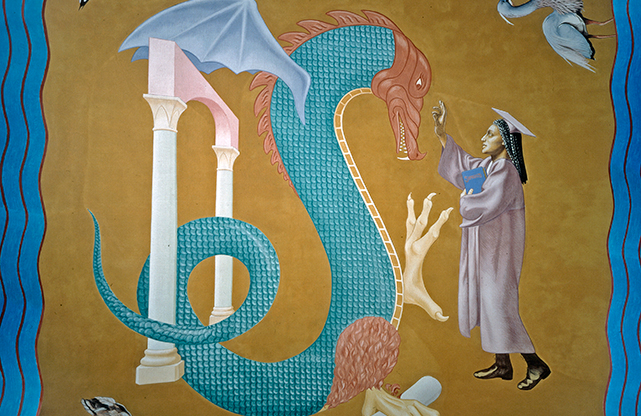
Hope is played out against a deep blue sky, dark before the rays of sun bring the promise of a new day. The figures represent the cycle of life. A woman holds up her newborn child, who represents a new generation in whom we place our dreams. The young man in the prime of his life is bent over, laboring in the soil. Near him is a flourishing fruit tree in full bloom. His hope is knowing that he will reap what he sows. On another level, we must remember that our hope lies in respecting and caring for the earth. The elderly woman completes the cycle, but she is not a static member of this scheme. She represents the universal grandmother who has laid the groundwork for us to sow our dreams. She carries compost in her wheelbarrow, showing that what dies does not end, but becomes the basic elements needed for new life. In the same light, the pinnacle of symbolic hope in the Christian tradition is the lamb. Amid darkness is the sun, or the Son of the world, who sacrifices himself as the pure lamb in order that we may have the essence of hope.
Bessie Gamble, a Bridge for Success student, spoke about the "Hope" panel. She chose to read Emily Dickinson's poem No. 254:
Hope is the thing with feathers
That perches in the soul
And sings the tune without
the words
And never stops - at all
And sweetness - in the gale - is heard
And sore must be the storm
That could abash the little bird
That kept so many warm
I've heard it in the chilliest land
And on the strangest sea
Yet never an extremity
It asked a crumb of me
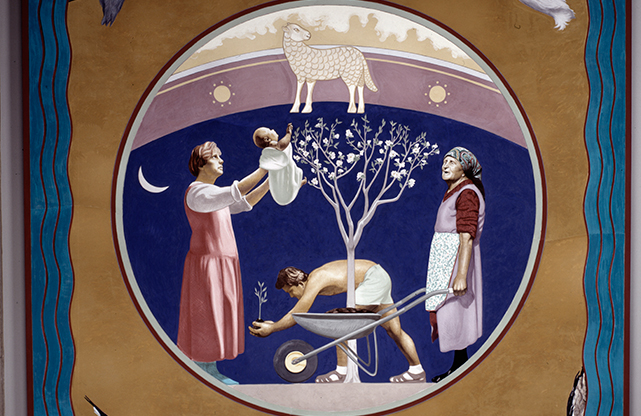
This virtue is the condition or quality of being temperate (exercising moderation and self-restraint). In Balma's depiction, temperance is depicted as the ability to remain free of distraction and focused on a goal. A stoic woman walks amid a fantastic forest filled with strange beasts. They depict the vices of temptation that face us. The grasshopper reclining on an anthill represents idleness, calling to mind Aesop's fable of the Grasshopper and the Ant. It is seated in front of a television, which Balma considers a potential instrument of a wasted mind. The satyr, half-man, half-goat, traditionally offered wine; but instead, here he offers a bag of drugs. The strange figure in the tree was inspired by the ancient siren, half-woman and half-bird, who sang seductive songs to lure sailors off course toward eventual destruction. Here a rock music diva becomes a contemporary siren. The monkey in the other tree accuses with a pointed finger, but is blindfolded as well. It represents prejudice. The fox, dressed in the garb of a religious man, offers the olive branch of peace while concealing a dagger; he feigns virtue while symbolizing treachery and is a comment on the many wars that have been raged over religious differences. The pig, traditionally the symbol of gluttony, holds a globe covered with the by-products of careless overconsumption.
On Oct. 20, 1994, an open house was held to celebrate the completion of the Frescoes of St. Thomas. Seven community members were invited to comment about what each panel meant to him or her, personally.
Kandis Knight, a city of Minneapolis Scholarship recipient, spoke of the Temperance panel.
"Although the images of the past, shown in this fresco of Temperance are from long ago – the siren, the fox – Balma has shown us how current their symbolism is. He seems to know that today's society is such a very different one for our children. I have tried hard to teach my children, Brandon, Kandis and Joe, the simple meaning of right and wrong. The simple sentence, 'Just say no.' The simple lesson of respecting one's health and one's self. I do this with genuine – and constant – love and interest in their lives."
Recently, Ms. Knight sent me this letter, I was so moved, I asked if I could add this letter to her previous comments about this panel. With her permission, here is the letter dated 10/18/99:
I just thought I'd write to give you an update. October 20, 1994 I spoke on behalf of my mother about the virtue of "temperance", I now have my own child and a husband, I have graduated from St. Thomas and I am a law student at William Mitchell College of Law and a part-time law clerk at the Minneapolis City Attorney's Office. I now fully understand what temperance is and I can fully appreciate it. I remember speaking that day, and saying great things about what I thought temperance was from the perspective of a 19 year-old college student.
I just want you to know that truly am that stoic woman walking amid that fantastic forest filled with strange beasts, in 1998 I became the first college graduate in my family (maternal and paternal), I conqured the distractions of poverty, the gangs, the drugs and the crime to give a future to myself, my child and all of the children in my family who look up to me. I was tempted millions of times to give up, but I refused. I was tempted by drugs and the underworld lifestyle....but I fought against all of these things and I almost didn't make it, but now my feet are planted on firm ground and I can say that I truly understand what temperance is about.
That moment I spoke about temperance is forever burned into my consciousness and it may even be the reason why I fought so hard to get to where I am today. So I kindly thank St. Thomas and who ever chose me to speak about temperance. One day I hope to be in a position to contribute to such a fine institute of higher learning.
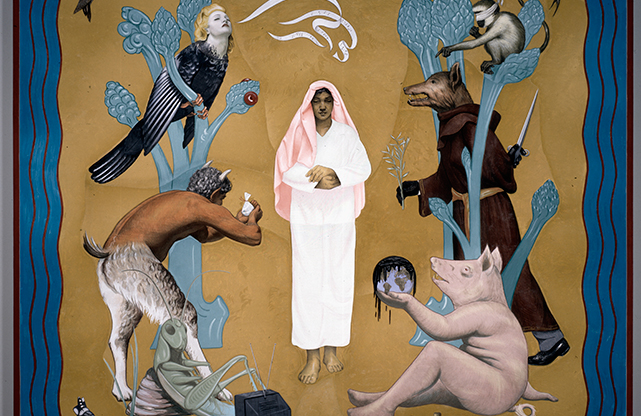
In medieval times, when chivalry was prized, the virtue of fortitude was depicted by an allegorical person with a sword; thus, fortitude too often is misinterpreted as physical strength. Within American history, however, one of the most prominent examples of fortitude can be found in the African-American experience. In Balma's work, two main figures, draped in colorful, native dress, have persevered to retain part of their heritage; nevertheless, they stand strong. The mule, in the center, is an interesting blend of a horse and a donkey. It is the symbol of oppression, the beast of burden. It also represents the "40 acres and a mule" promised to freed slaves by the post-Civil War government. The two figures unleash the mule from the bridle, having surmounted adversity. The woman takes an active role in the bridle's removal because she has been considered as the lowly of the low. Her exposed breasts represent strength, in the literal sense of nourishment which comes only from a woman.
On Oct. 20, 1994, an open house was held to celebrate the completion of the Frescoes of St. Thomas. Seven community members were invited to comment about what each panel meant to him or her, personally.
Matthew Little, former president of NAACP Minnesota, spoke about the "Fortitude" panel:
"Having witnessed from a front-row seat, so to speak, the unfolding of the Civil Rights Movement of the '60s, in which nonviolent confrontation won over legalized repression, I am able to find personal empathy in the symbolism of fortitude depicted in this beautiful work. On behalf of my departed friend, Gleason Glover (past president of the Minneapolis Urban League), whom I regret did not live to take part in this celebration, I am proud of the infinitesimal part that we might have had in the advising of this section."
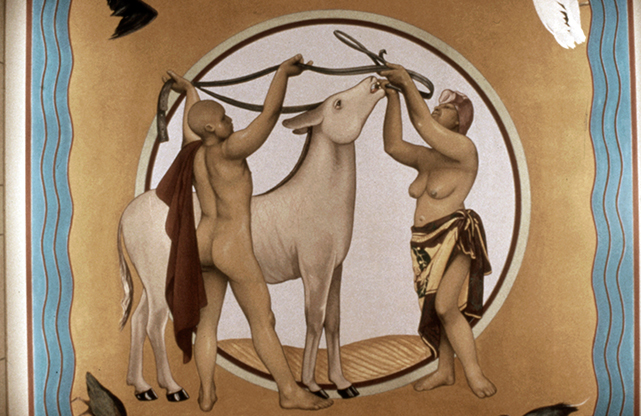
St. Thomas Aquinas called charity the greatest of the virtues. This panel, located at the end of the ceiling as you ascend the grand stairway, gives the viewer the physical sensation of being led upward to this virtue. Charity is played out on a city sidewalk; a woman cradles a lifeless figure. A mythical pelican envelops the couple and offers its own blood from its plucked breast to revive the figure.
The medieval story says that the pelican killed its misbehaving young. After grieving for three days, it plucked its own breast and fed its young with revitalizing blood. The lesson of this story is that we, too, are like the pelican. Without empathy or concern for others, we wither as well. Dante called Christ "nostro pelicano," likening the legend of the pelican to the Passion of Christ.
Christ said in John 13:34, "That you love one another. Just as I have loved you, you also should love one another." Charity is more than the mere act of giving what is surplus; it is giving of ourselves
On Oct. 20, 1994, an open house was held to celebrate the completion of the Frescoes of St. Thomas. Seven community members were invited to comment about what each panel meant to him or her, personally.
Herbert Bissell, lifelong volunteer, spoke about the Charity panel:
"To me, as with Paul, 'charity' is inevitably a partner with 'love.' But by itself, in contemporary society, the word 'charity' is frequently related to the outcast, the most helpless of us all. Love, on the other hand, has no dimensions. It is all-encompassing, all-embracing. So I would prefer this panel to symbolize the totality of love rather than "charity." The imagery of this speaks to this, and tells us that the message of love is for all humanity to capture, the good people, the bad, the weak, the strong, all faiths, everyone in this room. No one, no one, can successfully live without showing love to other.
